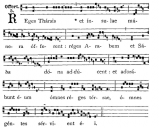Ave Maria- A New Mode VII Original Gregorian Chant
-
+
PAX
Here is a new Mode VII Original Gregorian Chant: https://youtu.be/Jxl2KOujilo
The Hail Mary is the most ancient prayer to the Mother of God, composed by God, The Father, Himself! This most beautiful of prayers, delivered by the Archangel Gabriel to The Most Pure and Humble Virgin Mary was the presage of Our Redemption!
It is offered here in a new Original Mode VII Gregorian Chant, sung and Copyright by the Traditional Benedictine Monks of Our Lady of Guadalupe Monastery, in Silver City, New Mexico.
Please feel free to use it for all non-for-profit liturgical use.
Ut in Omnibus Glorificetur Deus!

 Ave_Maria_Ave_Joseph_The Final_March 2019.pdf67K
Ave_Maria_Ave_Joseph_The Final_March 2019.pdf67K -
Thank you brother, very beautiful and nice job on the video.
-
I find interesting, and rather unusual, the (descending) augmented fourth (tritone) "Ti Fa" that occurs on "-na Do-", "-bus et", "-a mor-", and "-ia. Al-". Such leaps or descents of a tritone are almost never seen in Gregorian chant.Thanked by 1M. Jackson Osborn
-
I find the overly repetitive do-ti motif rather tedious, plus, it spoils the flowering of melody.
The tritone is not only jarring but creates modal confusion.
(Is there an example of the tri-tone elsewhere in the Gregorian repertory?)
Otherwise it is quite nice. -
Actually, the inspiration for these two similar pieces (Ave Joseph was written first, before Ave Maria, as you might guess!) was the 6th Responsory on Good Friday. It has a beautifully haunting sound in the Fa-La-Do climb on the words: et fácta est míhi and heréditas méa, following the preceding descent. That climb you also see between the words Mea and Sicut. The "Devils Fourth" as I believe it is called happens here, but in reverse. I had always loved the beauty of this Responsory, which after Tenebræ Factæ Sunt, was always my favorite!
The do-ti is typical in Mode VII Responsories, for example, Responsory IV on Holy Saturday. And the Repetition is seen in the Offertory for Epiphany: Reges Thársis.
This repetition was to emphasize the words, María, grátia pléna, and Benedicta Tu in mulieribus, Her singular Privilege of The Immaculate Conception!
This is not exactly a typical Mode VII Hymn to Our Lady! Yet, I hope the importance of the text allows for Chant that incorporates some very typical Mode VII motifs, but in an original and somewhat unique way. A little more in the very Mystical style of St. Hildegarde. (We in no way mean to compare our mediocre Chant to the Saint's!)
Thanks for the criticism
Brother Monk
 Responsory 6 Good Friday.png1606 x 1272 - 1M
Responsory 6 Good Friday.png1606 x 1272 - 1M
 Responsory IV Holy Saturday.png814 x 1028 - 379K
Responsory IV Holy Saturday.png814 x 1028 - 379K
 Offertory Reges Tharsis.png776 x 624 - 221K
Offertory Reges Tharsis.png776 x 624 - 221K -
We found a mistake in the Ave Maria PDF and we updated it!
God bless you all!
Brother Monk
 Ave_Maria_Ave_Joseph_The Final_March 2019.pdf67K
Ave_Maria_Ave_Joseph_The Final_March 2019.pdf67K
Welcome to the MusicaSacra Forum!
To participate in the discussions on Catholic church music, sign in or register as a forum member, The forum is a project of the Church Music Association of America.
Categories
- All Discussions21,107
- General Music Discussion8,218
- Job Openings197
- Management of Music Programs850
- Choral Matters533
- Church Documents and Rubrics524
- CMAA Notes302
- Events716
- For Newcomers: Read First26
- Sacred Polyphony546
- Hymnody872
- Gregorian Chant: General2,697
- ↳ Graduale Romanum and Liber Usualis368
- ↳ Graduale Simplex60
- ↳ Semiology63
- Vernacular Plainsong696
- Anglican Use and Anglican Chant68
- Organ, Other Instruments and Repertoire435
- New Composition/Works in Progress1,291
- Recordings231
- Music for Hispanic Ministry159
- Music Education: Children211
- Music Education: General222
- News Items245
- Positions Wanted2
- General Discussion: Catholicism739
- Amusements177
- General Discussion1,033
- Opinions117


